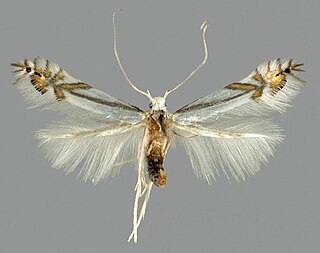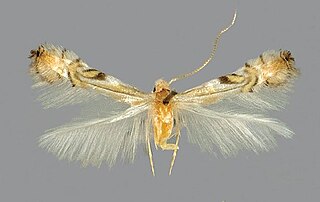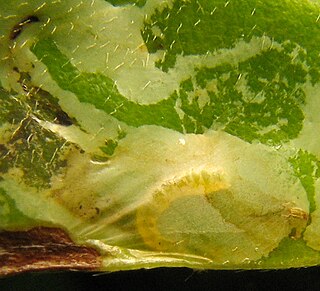Related Research Articles

Gracillariidae is an important family of insects in the order Lepidoptera and the principal family of leaf miners that includes several economic, horticultural or recently invasive pest species such as the horse-chestnut leaf miner, Cameraria ohridella.

Phyllocnistis tropaeolicola is a moth of the family Gracillariidae. It is known only from Cerro de la Muerte, Villa Mills, at 3,100 m elevation in the Cordillera de Talamanca in Costa Rica.

Phyllocnistis is a genus of moths in the family Gracillariidae.
Phyllocnistis argentella is a moth of the family Gracillariidae, known from Rennell Island in the Solomon Islands. It was described by J.D. Bradley in 1957, originally under the genus Opostega.
Phyllocnistis argothea is a moth of the family Gracillariidae, known from Bihar, India. The hostplant for the species is Drypetes roxburghii.
Phyllocnistis bourquini is a moth of the family Gracillariidae, known from Argentina. The hostplant for the species is Tessaria integrifolia.
Phyllocnistis breynilla is a moth of the family Gracillariidae, known from Guangdong, China.
Phyllocnistis chlorantica is a moth of the family Gracillariidae, known from the Russian Far East. The hostplant for the species is Chloranthus japonicus.
Phyllocnistis citronympha is a moth of the family Gracillariidae, known from Maharashtra and Karnataka, India. The hostplants for the species include Lannea coromandelica and Odina wodier.
Phyllocnistis cornella is a moth of the family Gracillariidae, known from the Kuril Islands, Kunashir, Russia. The hostplant for the species is Cornus controversa.
Phyllocnistis echinodes is a moth of the family Gracillariidae, known from Maharashtra and Karnataka, India. The hostplant for the species is Anamirta cocculus.
Phyllocnistis embeliella is a moth of the family Gracillariidae, known from Guangdong, China. The host plant for the species is Embelia lacta.
Phyllocnistis endoxa is a moth of the family Gracillariidae, known from Maharashtra and Karnataka, India. The hostplant for the species is Aporosa lindleyana.

Phyllocnistis magnoliella is a moth of the family Gracillariidae, known from the United States. The hostplants for the species include Magnolia acuminata, Magnolia grandiflora, Magnolia umbrella, and Magnolia virginiana.
Phyllocnistis nepenthae is a moth of the family Gracillariidae, known from Sumatra, Indonesia. The hostplant for the species is Nepenthes tobaica.
Phyllocnistis rotans is a moth of the family Gracillariidae, known from Ecuador. It was described by E. Meyrick in 1915.
Phyllocnistis sciophanta is a moth of the family Gracillariidae, known from Peru. It was described by E. Meyrick in 1915.
Phyllocnistis sexangula is a moth of the family Gracillariidae, known from Peru. It was described by E. Meyrick in 1915.

Phyllocnistis hyperpersea is a moth of the family Gracillariidae. It is found from Nansemond and Virginia Beach Counties in Virginia, south along the lowland Atlantic coastal region to the Florida Everglades. It might have a much wider range, since material which might belong to this species has been recorded from Honduras and Mexico.
References
- 1 2 Phyllocnistis puyehuensis Davis, 1994 at the Global Taxonomic Database of Gracillariidae (Lepidoptera).
- ↑ Davis, D. R. 1994. Neotropical Microlepidoptera 25. New leaf-mining moths from Chile, with remarks on the history and composition of Phyllocnistinae (Lepidoptera: Gracillariidae). - Tropical Lepidoptera 5(1):65–75.